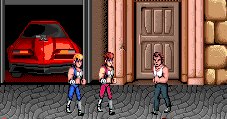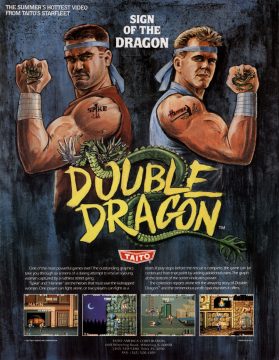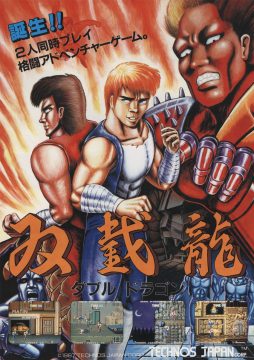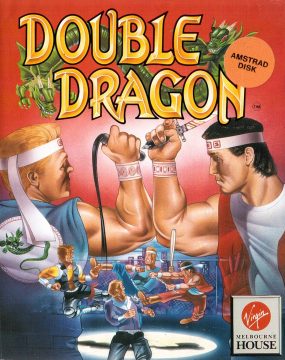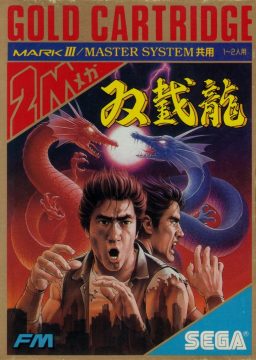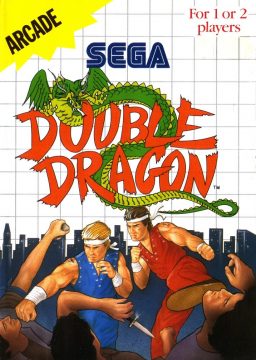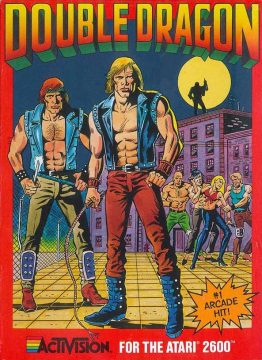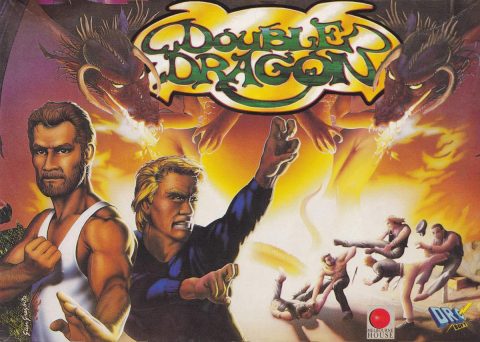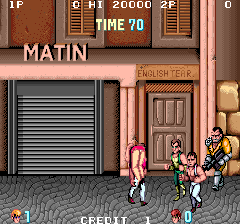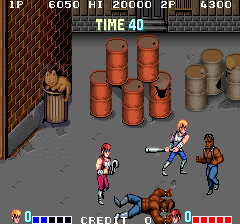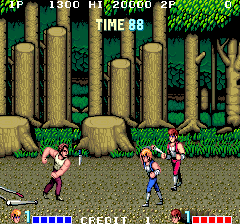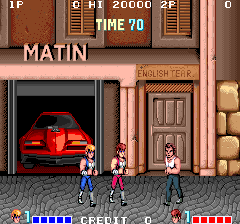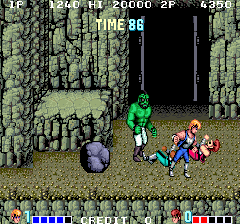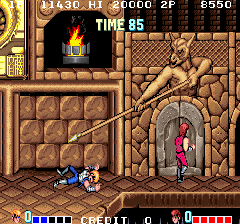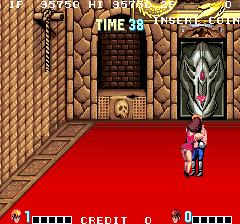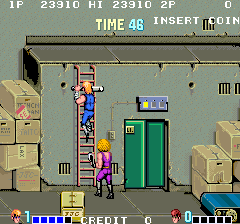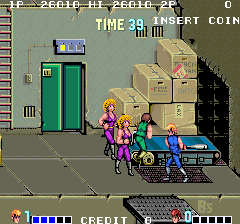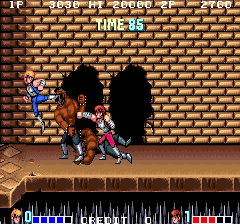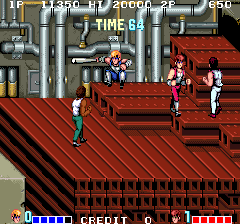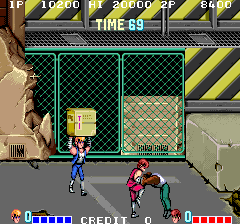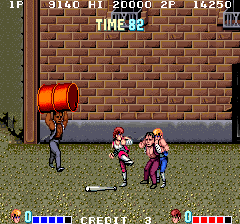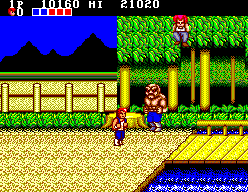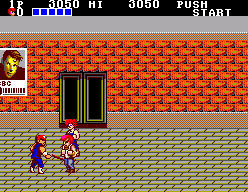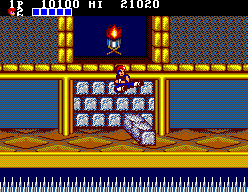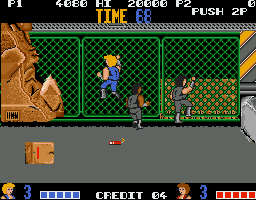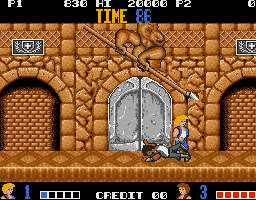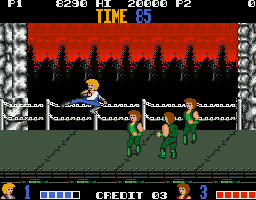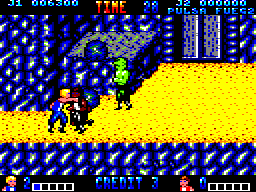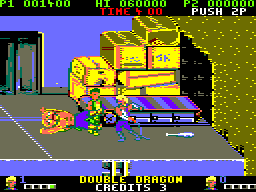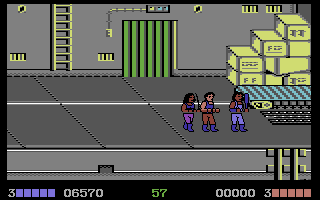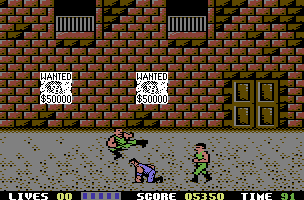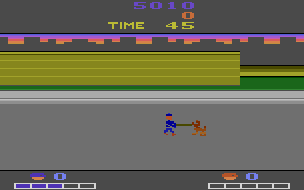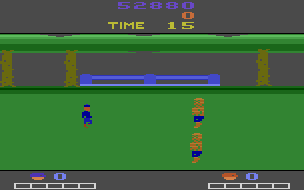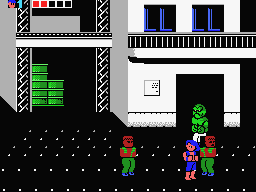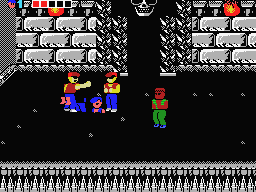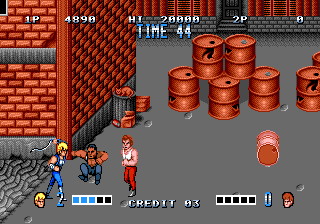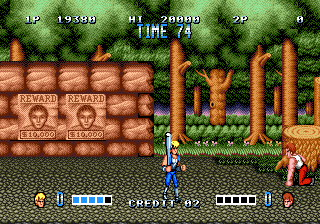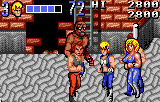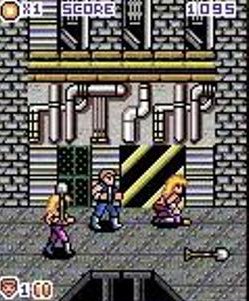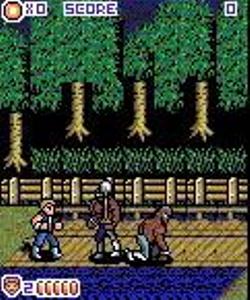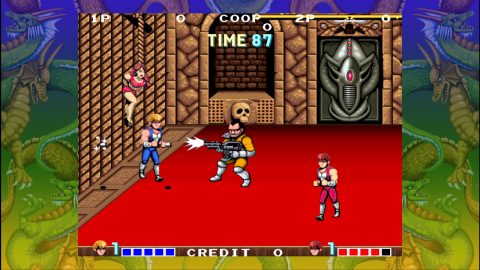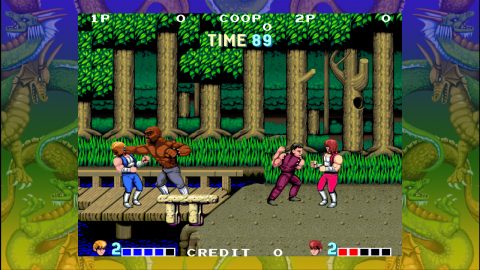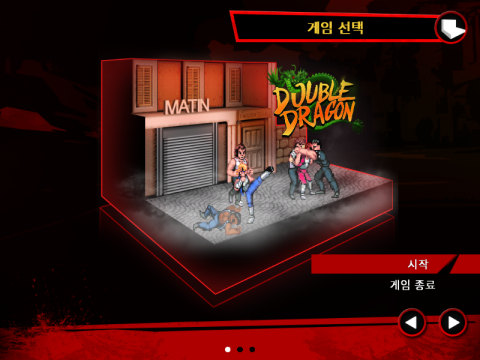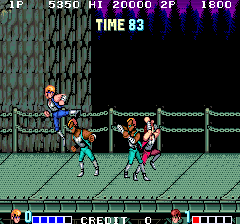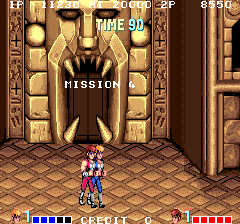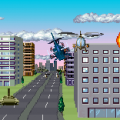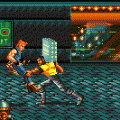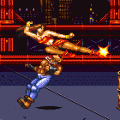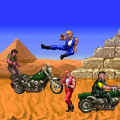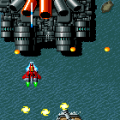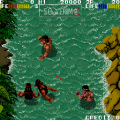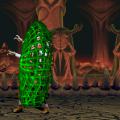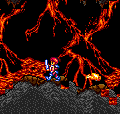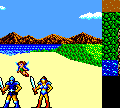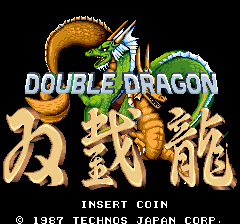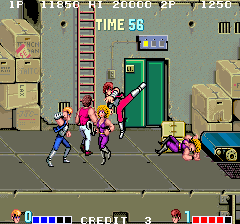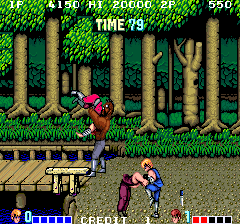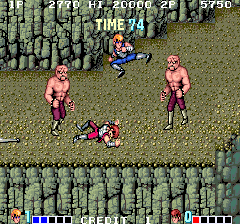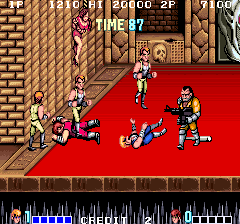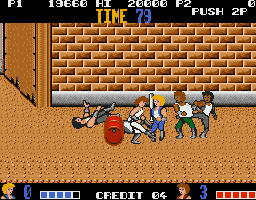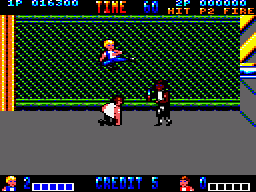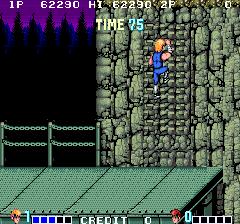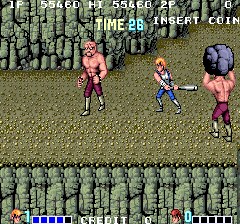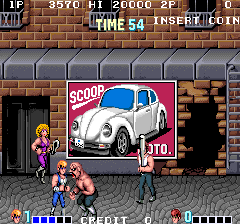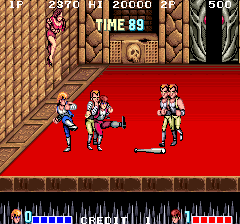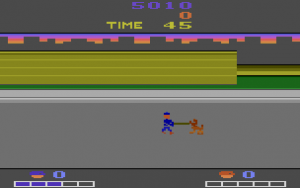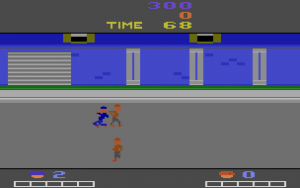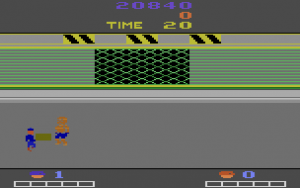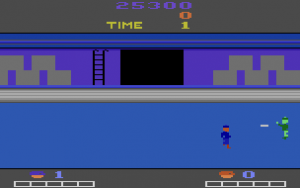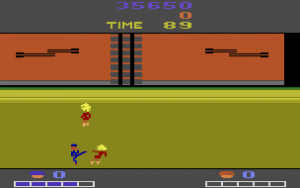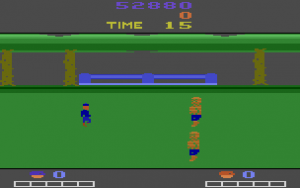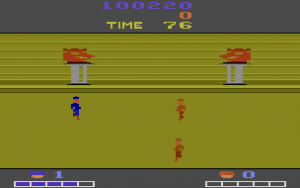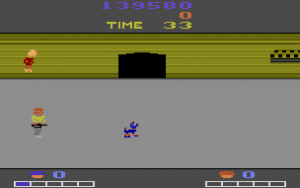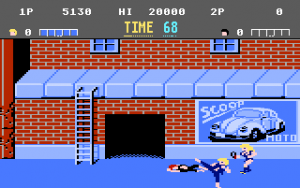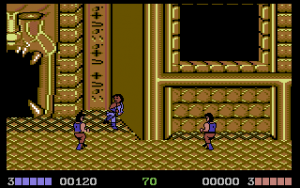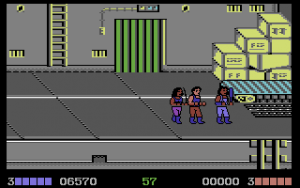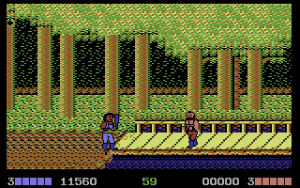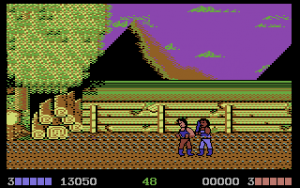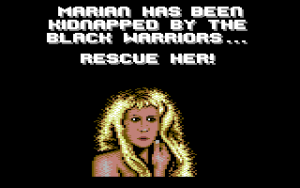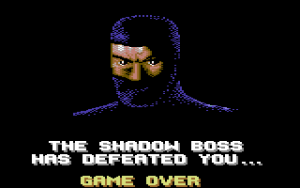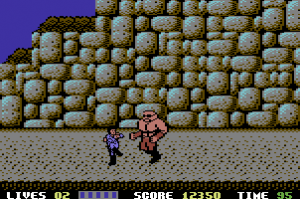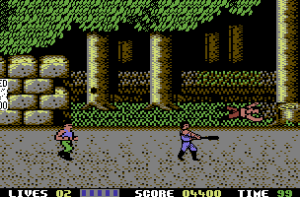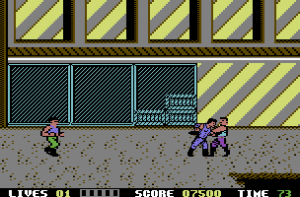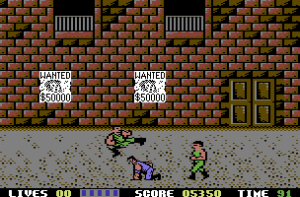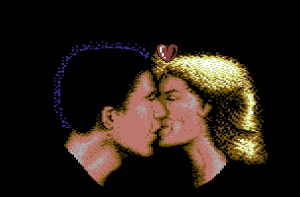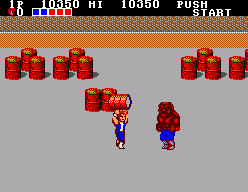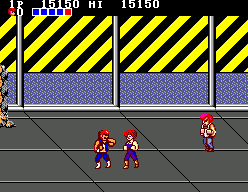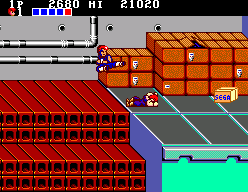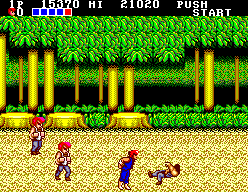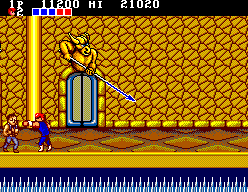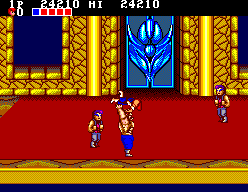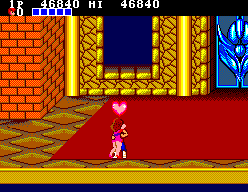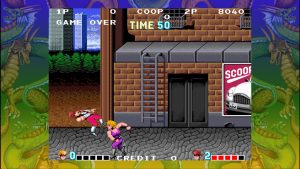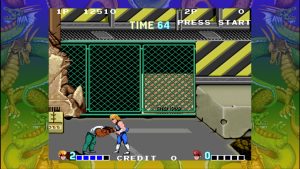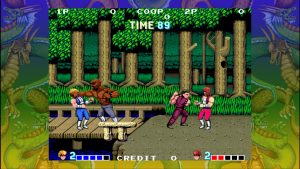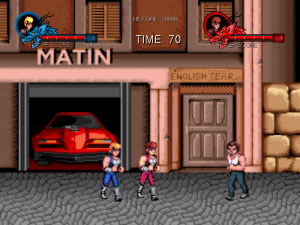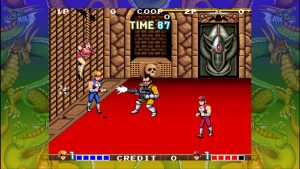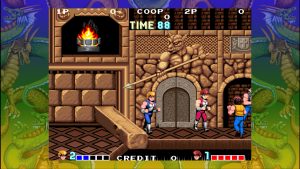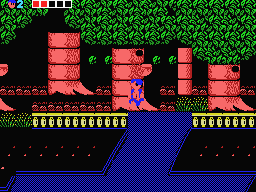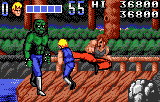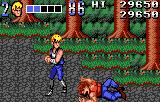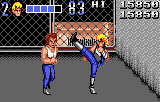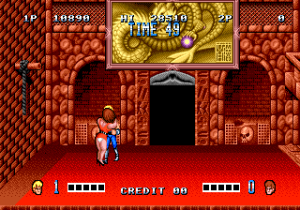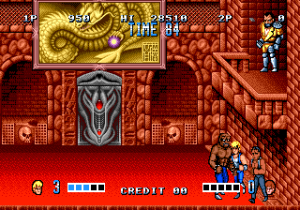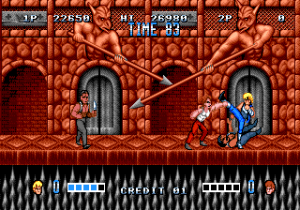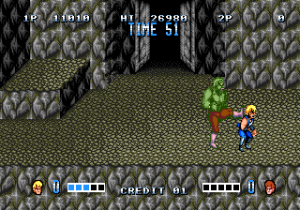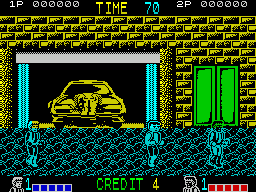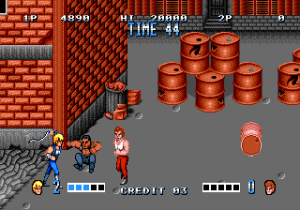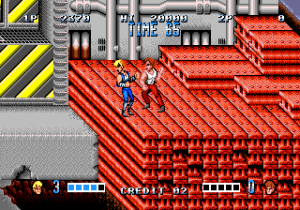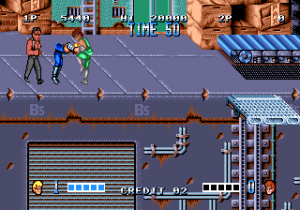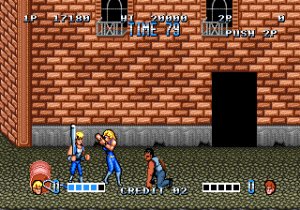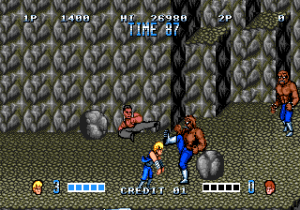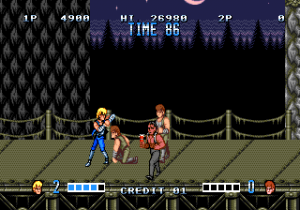- Double Dragon
- Double Dragon (NES / Game Boy)
- Double Dragon 2 (Arcade)
- Double Dragon II (NES/PCE)
- Double Dragon 3 (Arcade)
- Double Dragon III (NES)
- Double Dragon II (Game Boy)
- Super Double Dragon
- Double Dragon: The Revenge of Billy Lee
- Double Dragon V
- Double Dragon (Neo Geo)
- Rage of the Dragons
- Double Dragon Advance
- Double Dragon (Mobile)
- Double Dragon II: Wander of the Dragons
- Double Dragon (Zeebo)
- Abobo’s Big Adventure / Fighting of Double Dragon
- Double Dragon Neon
- Double Dragon IV
- Double Dragon: Other Media
Technōs’ Double Dragon opens with a group of tough guys, members of the evil Black Warriors gang, apprehending a woman in a bad part of the city. One of them walks up to her, punches her in the stomach, loads her on his shoulders, and carries her away. The scene might feel a bit awkward in light of today’s atmosphere in the gaming world, but in 1987 this was the way to establish the players’ motivation and mission in an arcade game within five seconds: As soon as the villains leave, the garage door opens to reveal the martial arts masters (and brothers) Billy and Jimmy Lee, who of course have to rescue their would-be girlfriend Marian, beating up every single hoodlum in their way. (It does seem weird she didn’t try to get away or make some noise with her bodyguards just inside the garage, but thoughts that deep go beyond what could be expected from arcade game storytelling almost thirty years ago.)
Even though Double Dragon made major contributions to codifying the formula that later became known as the beat-em-up genre, it was hardly the first game where the heroes run around beating hordes of bad guys with their fists and feet. Developer Technōs had made first strides in the genre before with Nekketsu Kouha Kunio-kun, a game about delinquent high school students fighting each other and getting in trouble with the armed mob. In fear the cultural references might be lost on an American audience, the game – now renamed Renegade – had the visual design of its characters and backgrounds changed to live and breathe the flair of the 1979 film The Warriors. Its dystopian vision is of a near-future New York that just got dirtier and dirtier, and more and more controlled by street gangs, an image which hadn’t lost its cultural relevance (see also: the 1990 Teenage Mutant Ninja Turtles movie).
Renegade wasn’t all that great and only found a couple of semi-unofficial sequels in the European home computer scene, while the Kunio-kun series continued in its original direction in Japan. But its Americanization process apparently inspired Technōs to distill the dark eighties gang violence setting and mix it with Eastern influences into a new thing of their own. Thus, Double Dragon was born.
Besides dystopian near future fictions such as The Warriors, Mad Max and Fist of the North Star, designer Yoshihisa Kishimoto took much inspiration from the Bruce Lee movie Enter the Dragon. So of course the twin protagonists Billie and Jimmie, the titular Double Dragon, bear the last name Lee. But there are several more subtle references as well: Half of the enemies are named after characters from Enter the Dragon, and the car in the garage Billy and Jimmy step out of in the beginning has a supercharger not unlike the one on Max Rockatansky’s Pursuit Special (though canonically it’s the same one as featured in the FMV car-action game Road Avenger, which was also directed by Kishimoto).
To properly honor their inspiration, the Lee brothers refined their martial arts prowess way beyond the brawling seen in Renegade. The basic moves are just jump, kick and punch, but these can be combined for a wide variety of attacks. The standard flying kick looks especially close to Bruce Lee’s posture, but there’s another variant for pressing jump and kick exactly at the same time, which makes the brothers turn around in the air. Jump and punch together intercepts enemies approaching from behind with an elbow blow. As in Renegade, enemies hunch over after a few hits, which leaves them open to finish the combo with a roundhouse kick or grab them. From the grapple they can be worked with a few knees to the stomach or thrown, smashing their own companions over with their body weight.
Double Dragon also introduces a new innovation to facilitate cooperative play, which surprisingly is the one element almost none of imitators have copied: Opponents can be grabbed from behind, incapacitating them so your partner can take them out. You also have to look out for this technique coming from your enemies, though, especially when playing alone. When grabbed, you still can kick forward and free yourself by ramming your elbows into your captor’s stomach, but it’s a slow animation that leaves you wide open for abuse.
Together with a friend, on the other hand, you always have to be careful not to beat each other up by accident, adding yet another dimension to the fighting with the need to spread out on the screen. This is turned around spectacularly in the end, as the brothers realize there’s two of them, but only one damsel in distress. Without batting an eyelash, they immediately turn against each other and fight for the rewarding kiss. Looking back at it now, it comes off as terribly retrograde, but for players of the first hour it was a mindblowing surprise. (This was also parodied to questionable effect in Castle Crashers over two decades later.)
A few elements have been removed since Renegade. Presumably it’s the heroes’ honor as true martial artists that prevents them from following downed foes to the ground to perform plastic face surgery with their fists. There is also no running, as double tapping a direction results in a head butt instead. This makes the fighting feel stiffer and slower, but also much more methodical and controllable than the chaotic Renegade.
Double Dragon may not have been the first beat-em-up, but it was the first to introduce the belt scroll formula the genre became identified with for the next decade. Whenever the heroes encounter a group of enemies, the scrolling stops at a certain point, only allowing them to go on when the mob has been cleared out. Double Dragon comes with the additional peculiarity that all four stages are part of one continuous world, which makes for a nice coherent feel with no transitions.
Enemy variety has rarely been the strength of the beat-em-up genre, and that unfortunate trend started already with Double Dragon. Even though the Black Warriors come at the Lee brothers in the dozens, each type is identified with a specific personal name, another tradition Double Dragon passed on to its legacy. Unlike Final Fight, however, the game doesn’t actually display the names on screen. Williams and Rowper are the standard thugs who mostly differ by their attire and skin color, but attack with a variety of weapons. Linda, the only female enemy type, attacks with a dangerous whip, but goes down after only a few hits. The giant Bolo is much tougher, which is pronounced by his first introduction, where he smashes through a brick wall.
Abobo, the boss of the first stage, is just a black Bolo with a mohawk, who can easily grab the Lee brothers and casually toss them over his shoulders. Stage two introduces Jeff, a copy of the Lee brothers with evil eyes and a receding hairline. Guarding the Black Warriors’ headquarters at the end of stage three is just a green Abobo, but all the bosses reappear as normal enemies. The only unique foe is the gang leader Willy, who unfairly brings a machinegun to the fist fight, which can take a player’s life with a single hit.
It’s not like Billy and Jimmy entirely reject weapons, though. They’re eager to pick up and put to use whatever arms their adversaries may drop, from bats and whips to dynamite and throwing knives. Especially the latter deal a large amount of damage, but can be kicked out of the air with the right timing. There is also heavier stuff lying around the scenery, like oil drums, crates, and rocks, which stand ready for the taking by either side of the battle, and even can be kicked around so you don’t need to lose your current weapon to make use of them. Some of the weapons are really strong, and there is no limitation to their use as long as you can keep them on screen, but a single hit is enough to make you drop them, and it’s easy to mess up your game by making yourself a target as you try to pick them up again.
As a genre pioneer, Double Dragon wasn’t yet entirely committed to the brawling that stood at its center. For better or worse, the game mixes things up a bit with occasional platforming elements. At a few points it is possible to outmaneuver a group of enemies by climbing ladders, but there’s not much gained from this – you need to fight them anyway and falling down from a platform can even hurt you. The levels even have several bottomless pits that spell instant death for whoever falls into them, be it hero or hoodlum. Furthermore, the final stage is rigged with a number of traps, from blocks coming out of the wall to knock you down, to statues that come to life and rake you with their spears. The former especially are the most frustrating part of the entire game.
Double Dragon was a terrific game and a revelation when it first came out, but it still had a few weaknesses – partly due to inexperience, partly because it was just a little bit too ambitious for 1987 tech. When more than three characters (the maximum is six – the two players and up to four enemies at a time) are on the same height, the game experiences significant slowdown, which can be quite bothersome, especially when the game speeds up again at the most inconvenient moment. The backward attacks are shockingly overpowered – if you turn your back at them, most enemies blindly run into elbow blow range, making it easy to become untouchable as long as you manage to avoid getting surrounded from both sides. Most of all, with only four levels and seven enemy types including bosses, there’s simply not that much content here, despite comparatively large ROMs.
Maybe Technōs used all that space for the music, cause Double Dragon has one of the most smashing soundtracks of its era. The title screen with the Double Dragon logo opens with a pumping theme no martial arts movie would be ashamed of, which might have lured more players to the cabinet than any other attract mode. The first stage theme goes on with the same amount of power and a sound like an 8-bit rendition of a long hard rock song, including a mock guitar solo at the end of its loop.
In the industrial area of stage two, the music is a bit more laid-back and poppy, while the forest and enemy headquarters themes almost sound like out of a suspenseful crime thriller, but they both always return to a piercing action rhythm in between. Even the intermission for the stage transitions is a full tune, even though you never hear more than a few seconds in the actual game before the next music starts. Only the rapid staccato of the boss music might be a bit too nerve-racking for its own good. The final fight fortunately reprises the title theme instead.
Double Dragon was a smash hit in the arcades, so it didn’t take long for several home conversions to capitalize on the game’s ongoing popularity. The first and most famous was the NES port, but that deviates so much from the original game that it will be covered in greater detail in another entry. The competing version for the Master System, however, stuck close to its roots. All the original weapons and enemies are included. Only Abobo loses his mohawk and the manual doesn’t mention Bolo, but there are still variants with and without the grapple move.
While the NES game adds a lot more platforming, on the Master System much of it is stripped down instead. The game still has the iconic river crossing and the traps in the final stage, but that’s about it. The one change it shares with the NES game is the character design in a more Kunio-kun-like style. The background graphics are a bit on the monotonous side, and some animations look pretty bad. The amount of enemies on screen at any given time is down to three, which the Master System manages without slowdown, although there is a bit of flickering involved. The music is pretty bleepy by default, but the game also supports the Japan-only FM unit, which brings an excellent quality soundtrack that’s almost on par with the arcade. All the original music is intact and sounding pretty good on the PSG, but unsurprisingly the instruments are not quite as impactful.
The difficulty is completely messed up, though. The hit detection is stacked against you so much, even the elbow smash hardly ever hits its target. Throwing is next to impossible. Even when your move clearly connects first, your opponent’s attack often still counts as a hit, and it’s not uncommon to see your character crumble down to the floor after a succesful attack. Linda and the standard Bolo are still almost completely harmless, while Williams and Roper, supposed to be the most basic thugs, have an impeccable intuition for attack ranges. Early on it’s still possible to get them with jump kicks, but as the opponents become tougher, the only way to get the upper hand is clever outmaneuvering from vertical directions. Abobo and Jeff are almost impossible to beat without taking damage yourself, and Willy wouldn’t even need his army of goons as he can easily kick the Lee brothers’ asses on his own. In the arcade, you could always insert another coin when losing your last life at the very end, but here the game just brutally cuts off your otherwise endless supply of credits for the final stage (unless you execute a hidden cheat maneuver).
The home computer rights were mongered to the Virgin Mastertronic group, which commissioned the development to a group called Binary Design. The Amiga and Atari ST were capable to handle graphics very close to most 80s arcade games, but in the case of Double Dragon, this only worked out reasonably well for the backgrounds. The sprites rather look like “junior’s first pixel art”, with bad proportions and almost no shading. Music is limited to the title screen, while during play all you get to hear are the pathetic sound effects. The IBM PC version is basically the same, except also limited by the limited EGA palette, which makes for some very bad use of dithering on the sprites. These versions also break up the former stage 3 into two segments, presumably because it was too big to fit into memory. Bolo has been completely phased out in favor of Abobo now.
But the aesthetic compromises are the least of Double Dragon‘s problems on the 16-bit computers. In contemporaneous reviews, they were often considered too easy, but that judgment could only come from the 1980s British home computer scene, where a program was only considered a proper game after it crushed your soul and ate your children. Sure, the enemies are dumb as bread and eager to jump down pits like Lemmings, but they also show no restraint from ganging up on the player in a single large throng, often making it impossible to react. The game also allows five enemies on screen at once, even more than the arcade version. But the kicker are the traps in the final stage – they are almost impossible to pass without losing at least a few credits (which again have a hard limit of five). The horrible one-button controls with nonsensical combinations, like pressing diagonally down/front with the fire button for a jump kick, don’t make this any better.
The ZX Spectrum version is made from the same rotten core, except it’s actually easy. Most of your problems are solved by standing in front of the enemies while kicking, and even when things get messy, continuous jump kicks almost leave you invincible – if it weren’t for Abobo’s unfair ability to hit you from off-height where you can’t touch him. The only problem is that it takes forever to progress in this game, because all enemies are ridiculously resilient.
Oddly, there are two versions for the Amstrad CPC with completely different graphics, presumably from around the same time. Both are credited to Binary Design, but one is also noted as converted by Animagic and was predominantly published by DroSoft in Spain. Curiously, it’s the Animagic version that plays almost exactly like the Spectrum port, whereas the Binary Design port has a completely different feel. In the former two versions, you can just hold the attack button to keep dishing out pain, but the second Amstrad version requires pushing the button each time, which suddenly makes it much harder again. It’s also the only Binary Design port with music in the game, but it’s just the same boring tune throughout that sounds nothing like the arcade game’s music.
The worst trainwreck of them all is the Commodore 64 port, though. It can’t even do stage animations, so enemies that would appear from elevators or smash through walls just walk in from the edge of the screen like everyone else. Boss fights are skipped over, and the only two weapons are whips and bats. The controls don’t even work properly, and hitting enemies is a matter of sheer luck. To add insult to injury, the game gives you exactly zero credits to continue. This version is so shoddy, actually selling it was nothing short of a scam.
The C64 port was apparently so bad that Ocean felt compelled to produce a new version in 1991, programmed by Imagitec. It is better than the previous one, in the sense that it fulfills the bare minimum requirements of being called a working game, but for that it makes even more compromises. There are still no stage animations, Linda seems to be MIA and Abobo wears sunglasses for some reason. He also never appears on screen at the same time as the regular enemies. Weapons are down to just the bat, which disappears into thin air as soon as you get hit while wielding it. Besides the boss battles, most of the platforming segments are missing too, for good measure. It still has terrible controls (the game expects you to use the space bar for jumping while all other input is made through the joystick), terrible hit detection, and terribly unfair enemies. On the plus side, it actually features the soundtrack in a cool SID arrangement, but you have to choose between music and sound effects in the beginning.
Ocean’s Commodore 64 version adds a few neat portrait images as cutscenes.
Somehow the Atari 2600 experienced a small revival in the latter half of the eighties, and so a version of Double Dragon found its way on the system, courtesy of Activision. Suffice to say, it’s completely inadequate, but boy did they try. It already surprises with the optional versus mode, where two players get to fight against each other. All the enemies are in there, even though most of them are hardly recognizable as human characters. Platforming was removed entirely, and only four attacks remain in the game (punch, kick, elbow and jump kick), but the combatants can fight with sticks, throw knives, and even toss a crate around, which is more weaponry than any of the C64 versions offered.
There are always up to two enemies on screen, but the game actually tries to keep things fair, so each enemy is always confined to one vertical half of the playing field until the other is taken out. The same applies for the players in cooperative mode. Unfortunately, the hit detection is maybe the most misanthropic among all the versions. Since enemies hardly follow you vertically as long as there’s two around, there is next to no opportunity to outmaneuver them. They always attack from the perfect range and once they get you, they wail down on you relentlessly. Even clearing one single screen without losing a life is a major accomplishment.
But judging the port of a 1987 arcade game on the ten year older VCS feels like criticizing a toddler for failing at quantum mechanics. Activision’s Atari 7800 version, on the other hand, could have been a lot better. While it looks and sounds reasonably good, the controls are just as bad as the many computer ports, even though the system can rely on two-button controllers. Once again, it’s almost impossible to hit an opponent without taking damage in return. The game doesn’t grant you any credits, so even beating the first level requires a miracle.
Yet another port of Double Dragon appeared in 1989, but this one was never officially licensed. Instead it was put out illegitimately by Korean bootleg developer Zemina for the MSX-based console Zemmix. Enemies here all have a neat black box around their heads and move about as smothly as the digits on a digital watch. The game has only three types of foes – a bright skinned guy, a dark skinned guy and green Abobo, with no further color variants. There’s not even a proper final boss, just another Abobo who takes hundreds of hits. The moveset is converted properly, though some maneuvers like throwing are a bit tricky. Very rarely enemies drop a throwing knife, which is the only available weapon. Everything wouldn’t be too bad if it weren’t for the extremely annoying AI for enemies, who always sneak around areas the player can’t reach.
There was another version that came into being not quite legitimately, although Accolade didn’t fail to procure the rights from Technōs, but rather published their Genesis titles without a license from Sega under the label Ballistic. Released in 1993, it came pretty late, but it was the closest to an arcade perfect home conversion there would be for a long time. Abobo is still missing his mohawk and Jeff is now a pure palette swap of the Lee brothers, but otherwise all the enemies, weapons, stages and music tracks are in there.
The game has but one significant issue: The buttons react in a rather peculiar way, so while you could just mash buttons to perform combos in the arcade version, here you need to press them with a very specific timing, or else the game might not react. It’s a control scheme that still allows for playing the game perfectly once you’ve adjusted to it, but it makes things needlessly complicated, and quite frustrating when your timing is wrong. The AI, on the other hand, actually seems to have been improved, as the enemies have gotten a bit better at dodging the elbow attack. The game runs also quite a bit faster with no slowdown. Overall it’s a bit more difficult than the arcade version, but at least you can change the amount of lives and credits in the options menu, to a maximum of six each.
Also from 1993 was the Atari Lynx version by Telegames. The graphics are an even more direct transition from the original, but that is not a plus here: Instead of drawing new sprites and backgrounds to fit the tiny Lynx screen, everything is just zoomed in to the 160×102 resolution, which makes for less than a third of the original space. The controls are pretty solid, but once again the lack of continues makes this version almost unbeatable, despite shortened stages and selectable difficulty levels. There is also a “Practice” mode, which is completely pointless, as it just lets you fight against a single thug and then ends.
There have been two adaptions of the classic arcade game for traditional mobile phones. The first, created in 2003 by Korean developer M-dream and perhaps exclusive to that country, used the exact arcade graphics zoomed in to a tiny frame where you’d see hardly anything. One year later, Bandai came up with an alternative that uses smaller, cuter graphics to pay justice to the changed dimensions, and it actually featured a few new “weapons” like the shovels from the sequel and TV sets. This version was also released in the US, but both have to be assumed lost today. A review of the latter, as well as the source of these screens, can be found at the Double Dragon Dojo.
In the 21st century, Technōs successor Million and its licensees went on to produce several extended remakes of Double Dragon that will be covered separately, but the first arcade accurate home version appeared on the Xbox Live marketplace in 2007. This was a perfect port of the arcade game, only with the slowdown removed. It featured optional retouched HD versions of the graphics that smoothened the pixels, but kept the game in its correct aspect ratio with a border around the action. In addition, it contained a little gallery with tidbits like a summary of the series and flyer scans. This version was completely removed from the marketplace only two years after its release – in contrast to other delisted games, it cannot even be redownloaded by those who have previously purchased it.
In early 2015, Double Dragon was bundled with the two arcade sequels into Double Dragon Trilogy for Windows, iOS, Android and Ouya. This compilation is by DotEmu, who are rather known for mixed quality, and this port likewise has its good and bad sides. You can now choose between three difficulty levels, which determines the durability of the Lee brothers and their opponents. On easy, most regular hoodlums go down after a single combo. There is also a “Story Mode” next to the standard arcade mode, but all it does is add a menu where you can select stages you have already beaten. The Trilogy version gets rid of the slowdown when many enemies are on screen at once, but in turn the scrolling has become really choppy.
The gameplay may be adapted faithfully enough, but the Trilogy falls short in aesthetic quality. The program includes an optional arranged soundtrack from the Original Sound of Double Dragon album, which sounds like any typical early 90s cheap synth soundtrack. Especially the stage 2 boss theme is terrible, with irritating sound effects from the game added into the mix for no good reason. The arranged music also is played at such a low volume it’s hard to hear over the sound effects, and there is no separate volume control for the two. The original music is still available, but since it’s in a streamed audio format, the tunes are faded out and restart if you take too long at a segment of the game.
Graphics options are quite limited. There is no option to preserve the pixel ratio, so ugly doubled lines/rows, a basic interpolation filter and scanlines are the only options to deal with the differing resolution. While the sprites and backgrounds all use the exact arcade graphics, the HUD is redrawn in high resolution, which clashes badly with the rest of the game.
Double Dragon may not have aged perfectly gracefully, but it’s far from being the arthritic, senile grandpa of the genre withering in his rocking chair, just waiting for his merciful passing. Its methodical gameplay in rejection of pomp makes it more worthy of revisiting than many of its flashier but shallower followers. If Technōs only had managed to build upon what it started here and channel its strengths with the following games, genre fans today would probably still be all over Double Dragon above even Final Fight or Streets of Rage.
